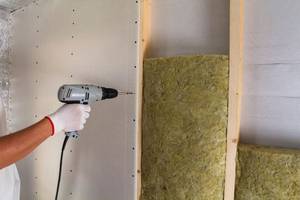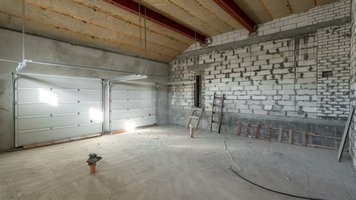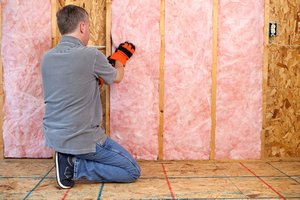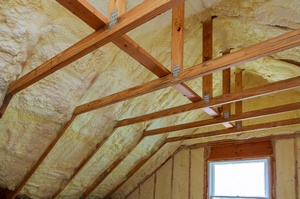Insulated Garage Doors: The Key to Temperature Control
This post contains affiliate links.
It’s the ideal time to prepare your garage for the impending winter as the weather becomes cooler. Metal garage doors do nothing to keep a reasonable temperature. They only effectively block powerful gusts. If you don’t want to shell out more than $1,000 for a brand-new, pre-insulated door, think about upgrading your current garage door.
Using an insulation kit is the easiest way to insulate your garage door. But if you don’t want to use one, you can insulate it by yourself. All you really need to do is measure your garage door, clean the garage door, cut out the insulation according to size, install the insulation, seal any gaps, and check for proper operation of the garage door.
Insulating a garage door is a relatively easy DIY project that can be completed with a few basic tools and materials. This guide will walk you through the steps of how to insulate a garage door, including what materials you’ll need and how to install the insulation.
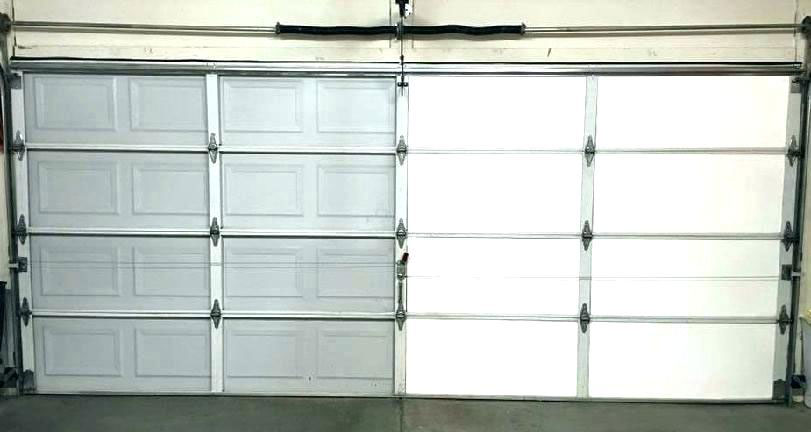
How to Insulate a Garage Door?
This guide will cover the materials and steps necessary to insulate your garage door properly.
Materials Needed
Here’s what you’ll need: (links to Amazon)
Garage door insulation kit (or roll of insulation and necessary installation materials)
- Measuring tape
- Utility knife
- Spray adhesive or caulking
- Staples or adhesive tape (if using roll insulation)
Step 1: Measure Your Garage Door
The first step in insulating your garage door is to measure the width and height of your garage door to determine how much insulation you will need to purchase.
Some garage door insulation kits are made to fit a standard size, while others are customizable to fit any size door. Be sure to measure carefully to ensure that you purchase enough insulation to cover the entire door.
Step 2: Clean the Garage Door
The next step is cleaning the garage door of dirt or debris. This will ensure that the insulation adheres properly to the door and that there are no obstacles in the way.
Use a broom or a damp cloth to remove any dirt or debris from the door, making sure that the surface is clean and dry before proceeding to the next step.
Step 3: Cut the Insulation to Size
If you are using a roll of insulation, cut it to the proper size for your garage door. Ensure the insulation is at least 1 inch smaller in width and height than the door to allow for adequate expansion and contraction.
This will ensure that the insulation doesn’t interfere with the door’s movement.
Step 4: Install the Insulation
If you are using a kit, follow the instructions provided by the manufacturer. Some kits have a foam panel that attaches to the door using adhesive or clips. Other kits have a reflective material that attaches using double-sided tape.
If you’re using roll insulation, you have a couple of options to install it:
- Spray adhesive is a good choice for attaching insulation to the back of the door. It’s easy to apply and will hold the insulation in place.
- Caulking can also be used to attach insulation to the door. It’s a bit messier than spray adhesive, but it can be more effective at filling gaps and crevices.
- You can also use staples or adhesive tape to secure insulation. Be sure to use enough to ensure that the insulation stays in place but not so much that it interferes with the door’s movement.
Step 5: Seal Any Gaps
Once the insulation is installed, you should seal any gaps or spaces around the edges of the door. This will help to prevent drafts and keep the insulation in place. A good option is using caulking or garage door weatherstripping;(paid link) it helps seal any gaps and also helps to prevent drafts.
Step 6: Check for Proper Operation
After installing the insulation, checking the door for proper operation is essential. Ensure that the door opens and closes smoothly and that the insulation does not interfere with the door’s movement. If there are any issues, make the necessary adjustments to ensure that the door operates properly.
Sometimes the garage door springs need to be adjusted to accommodate the added weight on the door.
For more information on how to insulate a garage door, watch this video below:
Which Garage Door Insulation Should You Choose?
Rigid foam and batt insulation are the two major kinds used for garage doors. Learning about both insulation kinds can help you choose which is ideal for your garage door.
Nevertheless, since any rolled batt that doesn’t arrive with a garage door insulation kit is probably too thick for the door, most people choose rigid foam.
Rigid Foam Insulation
Leaving the insulating kit behind? The most popular choice among do-it-yourselfers is foil-faced rigid foam board insulation panels, which can be measured and shaped to suit the grooves within your garage door using a sharpened utility knife or table saw.
Foil-faced and fire-rated versions of all three of the major foam board varieties are allowed for insulation for garage doors. Non-faced foam board should not be used since it is combustible, will release hazardous vapors if it burns, and may also be against local building regulations.
Expanded Polystyrene (EPS)
Expanded polystyrene foam, which comes in a variety of panel sizes and can be either firm or somewhat flexible, is applied to cover the interior of garage doors.
It features an R-value of around 4.6 per inch of thickness and is resistant to both moisture and temperature damage. It comes faced or unfaced and comes in a variety of sizes.
Extruded Polystyrene (XPS)
Extruded polystyrene is easy to recognize. It provides R-5 insulation for every inch of thickness. It comes in both faced and unfaced garage door insulating panels. It is available in green, pink, or blue foam boards.
Polyisocyanurate (ISO)
Since the boards are made by spraying a fluid upon a substrate, all polyisocyanurate foam panels have a face (typically made of foil). Their R-5.8 insulating value per inch of thickness is high. Although polyiso is frequently used in roofing, it may also be utilized to insulate a garage door.
Select foam board that is just a little thinner than the casings on the inside of a door. For instance, you might want to carve sections from a foam board that is 1 ½ inches thick since a typical garage door channel is around 1 ¾ inches deep.
While most garage door channels can differ widely, they include “lips” that keep the boards in place, but firm foam boards can still move around a little if they don’t fit tightly. Before actually installing a board, apply a small amount of foam-safe glue to the rear of the garage door channel to help keep it in place.
If required, you can use expanding foam to fill spaces between the boards’ sides, but remember that a small amount is more than enough. To verify suitability with the foam board you’re applying, look at the label of any adhesive and expanding foam spray. Certain adhesives will destroy foam boards.
Batt Insulation
The term “batt insulation” refers to the material’s shape, whether strips or rolls, instead of a particular kind of insulation. Insulation batts can be faced or unfaced and are manufactured from a variety of materials. Both conventional batts and systems for insulating garage doors are available. Batts, in contrast to hard foam, are adaptable and squishy.
Standard batt insulation is widely accessible and frequently somewhat less expensive than foam board. Still, it’s generally not the greatest option for garage door insulation if you aren’t utilizing a garage door insulation kit. You may have an extra roll lying around.
The smallest standard batt is 3 and a half inches thick, which is too heavy for most garage door channels and significantly diminishes the standard batts’ capacity to insulate a garage door when compressed.
If you’re determined to use batt insulation, look for thinner, 1½-inch-thick foil-faced batting at plumbing supply stores or purchase it on the internet (do-it-yourself centers seldom have it). This type is used to cover HVAC ducts.
The work is perfectly suited for the 1½-inch-thick Johns Manville batt insulation. You must also use proper glue and tape, as advised by the batting manufacturer, to keep the batts in place.
Insulation constructed of finely spun glass threads is known as fiberglass batt insulation. It is also the most popular and least expensive form of batt insulation. They are available in strips and rolls. Based on density, a 1.5-inch-thick fiberglass batt has a thermal resistance rating of R-4.7 to R-6.45.
Rockwool Insulation Batts
Rockwool insulation is a natural outcome of recycled steel that is blown into the fiber at extremely high temperatures. It is also referred to as mineral or slag insulation. A 1.5-inch thick rockwool batt has an R-value that ranges from R-4.3 to R-5.16, based on density.
Ceramic Insulation Batts
Ceramic batt insulation, a newcomer to the market, is manufactured from spun ceramic fibers and is mainly used to insulate the area surrounding high-heat equipment like furnaces. However, it may also be used to insulate garage doors.
It costs a little more than fiberglass or rockwool, but per 1.5-inch batt, it has a thermal value of R-6.45.
Why Insulating Your Garage Door Is Crucial
Insulating a garage door can have several benefits for a homeowner.
Comfort
One of the main advantages is that it helps keep the garage more comfortable year-round. In the winter, insulation can help keep the heat inside the garage, reducing the heat that escapes through the door.
This can lead to energy savings, as you may not need to run your heater as often to keep the garage warm. In the summer, insulation can help to keep the garage cooler by reducing the amount of hot air that enters the garage through the door.
This can also lead to energy savings, as you may not need to run your air conditioner as often to keep the garage cool.
Read all about best garage heaters here.
Also check this article for best garage coolers.
Reduces Noise
Another benefit of insulating a garage door is that it can help to reduce noise. If your garage is attached to your home, insulation can help reduce the amount of noise entering the house. This can be especially beneficial if you use your garage as a workshop or if you have a TV or stereo in the garage.
Increases Strength and Durability
Insulating your garage door can also increase its strength and durability. Most of the garage door insulation material is made with plastic foam which helps to increase the door’s R-value, which means a better insulation performance. When the garage door is exposed to changes in temperatures and humidity, the insulation helps protect the door and prevent it from warping or cracking.
Check out our buyer’s guide for the best garage door insulation kits!
Also, check the other articles on our insulation series covering the whole garage here.
Conclusion
Insulated garage doors can mean the difference between completing projects in a reasonable amount of comfort or not utilizing the workshop in the coldest or warmest months for people who use their garages as workstations throughout the year.

